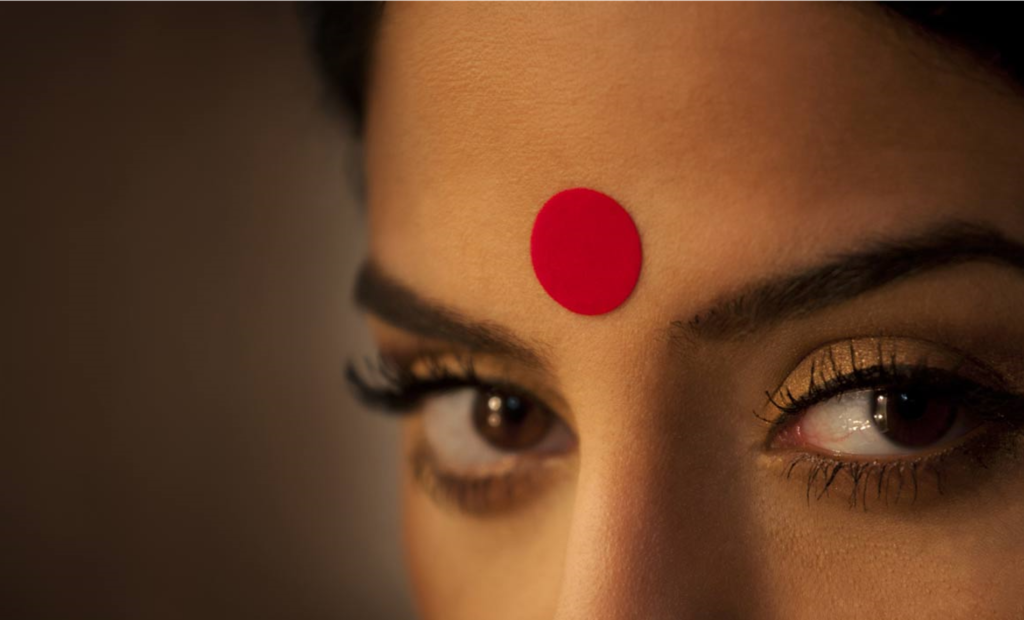Bindi or tilak is applied in the center of the forehead or on the sixth chakra which is located in between the two eyebrows. This spot is considered Ajneya Chakra which is deemed as the Commanding center. This Center controls the entire body. This is the only Chakra exposed to outside while the rest of the chakras are covered with either clothes or hair. This is the chakra that makes all the decisions. It is immensely important to protect from outside forces or evil eyes. This is the point that controls the entire body. Maharishi Yagyavalka said that this position is appropriate because Shiva’s third eye is located here. After the application of tilak pure thoughts are said to emerge. In fact, our scriptures say that a forehead without a Tilak is as good as a village without a well, a country without a river, a country without justice, etc.

Depending on one’s inclination, one may apply Tilak, sandal paste, or ash on the center between the eyebrows. Application of Tilak, Sandal Paste, or Ash will have a cooling effect, medicinal value, and spiritual influence. . Saivas apply three horizontal lines with the sacred ashes (Tripundra). The Vaishnavas apply three vertical lines (Urdhva Pundra) on the forehead. Fingers are used for applying the Tilak.
Brahma Vaivarta Purana, Skanda Purana, Brahmanda Purana, Padma Purana, and other Puranas talk about the significance of Tilak on the forehead. During religious ceremonies, the efforts bear no fruits if Tilak is not applied on the forehead.
Kumkum is most often applied on the forehead with a ring finger as one press on the eyebrow center. Both women and men should apply Tilak as per our scriptures. Our ancient Rishis used to press that center when applying Tilak to activate the pituitary gland in order to meditate better. The pituitary gland is a small organ, at the bottom of the brain. It is the master gland of the human body, this gland produces and secretes many hormones that travel throughout the body, directing certain processes stimulating other glands to produce different types of hormones. The pituitary gland controls biochemical processes important to our well-being.
The application also activates the pineal gland which may have the highest concentration of energy in the body. The pineal gland is also the dominant source of the body’s melatonin, which affects our mood, immune function, circadian rhythms, and sleeping patterns. When melatonin levels are disrupted, people can experience mood swings, depression, and seasonal disorders. The pineal gland also plays an important role in the production of serotonin which regulates moods, sleeping patterns, promotes digestion, and inhibits impulsive behavior.
Traditional Kumkum is made with Turmeric and Slake lime. Turmeric has anti-inflammatory and antioxidant properties. Traditional kumkum has many medical and spiritual benefits. It makes one calmer and helps arrest anxiety. Some of the benefits of applying Tilak on the forehead are: relieves headache, clears up sinuses, strengthens your facial muscles and can beat wrinkles, relieves the symptom of Bell’s palsy, good for the muscles of the eyes, stimulates hearing, beats insomnia, and others.

Bindi Stickers: For convenience and ease of application, many people are applying bindi stickers on their foreheads. These stickers are made out of glue and metals which may affect the very commanding center that we need to protect from chemicals and metals. These stickers are considered to have a negative effect on one’s health and spirituality.
In a survey conducted by the Consumer Unity and Trusts Society (CUTS), Kolkata, in November 2001, half of the respondents (consumers) said that they had suffered allergic reactions to personal care products. The synthetic adhesive used in sticker bindis may lead to eczema, leucoderma or skin irritation. The use of sticker bindis can cause white patches on the forehead. Another study also concludes that “The dermatological effects that have been linked with bindi use include contact leukoderma, allergic contact dermatitis and granuloma formation [6]. Our patient used sticker bindi. Long-term use of these bindis may be associated with local skin breach due to repeated and regular skin contact of adhesives on the “bindi.”

